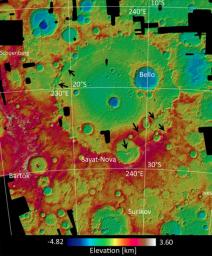This elevation map of the Beethoven basin is color-coded to show the height of features on Mercury's surface. Mercury lacks a "sea level", so the zero-point reference elevation is defined to be the mean planetary radius of 2440 km. Blue areas, such as within Bello crater on the floor of Beethoven, have negative elevations. The red and white areas to the southwest are more than 8 km higher than the lowest points in this area.
The images used to construct this DTM were acquired as part of MDIS's high-resolution stereo base map. The stereo base map is used in combination with the surface morphology base map to create high-resolution stereo views of Mercury's surface, with an average resolution of 250 meters/pixel (0.16 miles/pixel or 820 feet/pixel) or better. During MESSENGER's one-year mission, the surface morphology base map is acquired during the first 176 days, and the second 176 days are used to acquire the complementary stereo base map, which includes the image here.
Center Latitude: -20°
Center Longitude: 236° E
Scale: Beethoven basin is ~650 km (404 miles) in diameter
Image information: A digital terrain model (DTM) derived from Mercury Dual Imaging System (MDIS) stereo images. The lateral spacing is 330 meters and the map is in stereographic (conformal) projection. The image is taken from abstract number 1913 submitted to the 2012 Lunar and Planetary Science Conference, by Frank Preusker and colleagues.
The MESSENGER spacecraft is the first ever to orbit the planet Mercury, and the spacecraft's seven scientific instruments and radio science investigation are unraveling the history and evolution of the Solar System's innermost planet. Visit the Why Mercury? section of this website to learn more about the key science questions that the MESSENGER mission is addressing. During the one-year primary mission, MDIS is scheduled to acquire more than 75,000 images in support of MESSENGER's science goals.
These images are from MESSENGER, a NASA Discovery mission to conduct the first orbital study of the innermost planet, Mercury. For information regarding the use of images, see the MESSENGER image use policy.

 Planetary Data System
Planetary Data System












